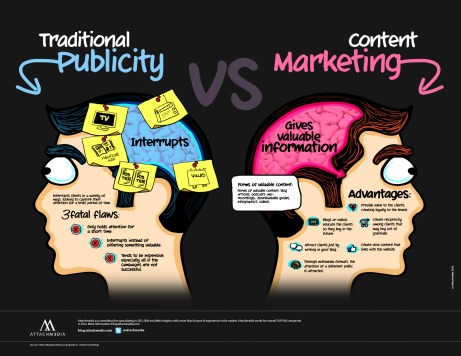
My final blog of this Emerging Media series is one of a reflection of what I have learned to be highly important as a potential marketer in today’s world of 24/7/365 mobile technology. To me, content marketing is of paramount importance among every single social media platform that is at our fingertips today.
With content marketing being on marketers’ hotlists today, I would like to take a few minutes to highlight several insights into this topic. I came across a recent HubSpot blog that was very informative to me, and I would like to share it with you! Some of the highlights include:
- When people hear information, they’re likely to remember only 10% of that information three days later. However, if a relevant image is paired with that same information, people retained 65% of the information three days later.
- Only 27% of marketers have a process in place to aggregate, organize, and manage the visual assets being used across their marketing teams.
- 9% of marketing professionals worldwide name video as the type of content with the best ROI.
- Between April 2015 and November 2015, the amount of average daily video views on Facebook doubled from 4 billion video views per day to 8 billion.
- Infographics are liked and shared on social media three times more than other any other type of content.
- Articles with an image once every 75-100 words got double the number of social shares than articles with fewer images.
So, what is a common thread among these statistics and the lessons we have learned throughout our course? Mobile consumers are highly visual. They/We better respond to messages with visual content in a variety of social media platforms. Consumers are inundated with information from every direction possible at any given time. Therefore, we/they require brief, direct messaging that cater to specific interests, needs and desires. A brand/company’s transparency and authenticity throughout its owned media platforms are ever-increasingly vital to the overall trust of that organization. Lastly, multi-channel communication that provides consumers with the opportunity for positive engagement is crucial in the world of emerging media today.
I also came across this great graphic that truly sums up the vast concept difference of what I formally learned while studying for my degree in Public Relations versus what I am studying now in Integrated Marketing Communications.

In both concepts, the consumer is the focus as both marketing efforts attempt to reach a brand’s audience. The key difference is in the two-way communicative relationship that emerging media affords each party today. That is exciting for both consumers and organizations.
I have learned a tremendous amount throughout this course that I am certain will benefit me. I am eager to apply these concepts both personally and professionally.
– Bethany




